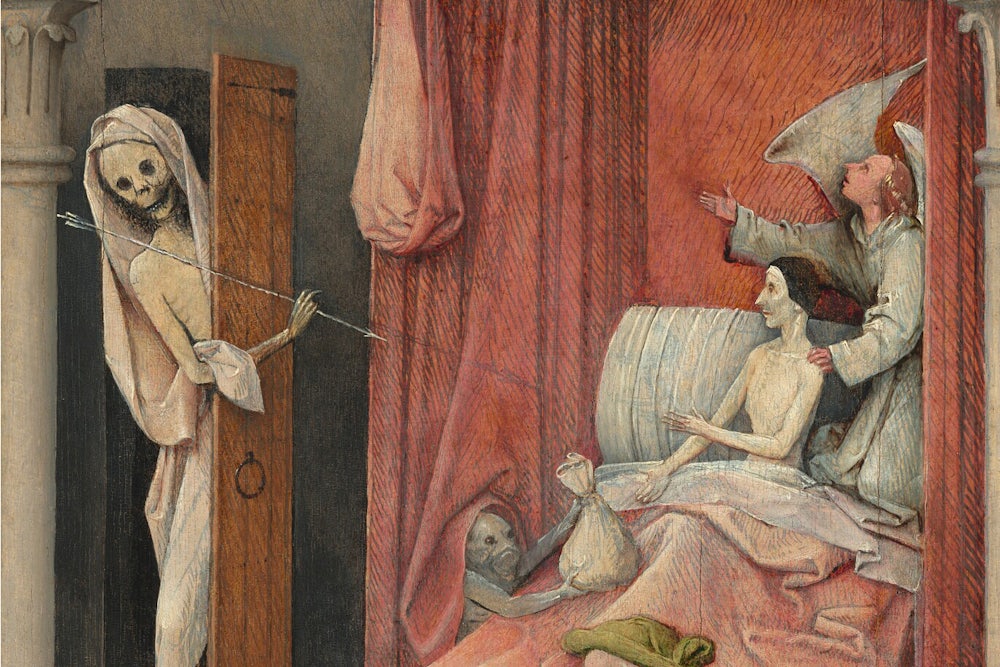On July 18, Brytney Cobia, a physician in Birmingham, Alabama, took to Facebook to talk about caring for Covid-19 patients. “One of the last things they do before they’re intubated is beg me for the vaccine,” Cobia wrote. “I hold their hand and tell them that I’m sorry, but it’s too late.” Cobia’s post, which has since been shared 16,000 times on the social platform and amplified in local and national news outlets, proved to be an early entry in a grisly new genre of pro-vax deathbed confessions from the unvaccinated, where the dying admit their mistakes and beg others not to repeat them.
Back in July, The Atlantic’s Daniel Engber called narratives playing up Covid’s dangers “Scared Straight programs for vaccines.” These deathbed confessions are a particularly morbid mutation. Initially, families and health care providers were sharing such stories to encourage healthy people to seek vaccinations while they still had the chance. Cobia said her efforts at persuasion were successful: The friends and family of her dead patients “thank me and they go get the vaccine,” she wrote at the time.
But there’s little evidence that this approach works for random spectators, who never knew the deceased personally. For people who refuse the vaccine on ideological grounds, or can’t access it because of harmful time-off policies, this macabre multimedia onslaught probably won’t amount to much—if they see it at all.
That hasn’t stopped the deluge of fresh content from death’s door. In one high-profile case, a TikTok user named Megan Alexandra Blankenbiller shared four videos from her hospital bed over 48 hours in August and told her followers to get vaccinated before it was too late. “I do think it was a mistake,” she said as her condition visibly worsened. “I shouldn’t have waited.” (Blankenbiller died nine days later, at age 31.) Now, news of Daniel and Davy Macias, an unvaccinated California couple, dying of Covid-19 mere weeks apart, is making the rounds. The couple left behind five children, including a newborn neither parent lived to name. Before dying, Daniel Macias reportedly encouraged the rest of his family to get vaccinated. At this point, every news outlet, from The New York Times to MSNBC, seems to have its own representative anecdote, and some go to great lengths to unearth new ones: In August, CNN’s Don Lemon flew to his hometown of Baton Rouge, Louisiana, to shove a mic in the faces of the sick and ask, “Do you regret it?”
If these micro–morality plays aren’t convincing the unvaccinated, who are they for? One can only conclude the vaccinated masses, who reportedly remain hooked on CNN and MSNBC for their Covid-19 coverage, according to one July poll.
It’s not hard to understand why vaccinated people might be drawn to these sad spectacles. They are righteously angry from spending the better part of two years confined, afraid, and on the wrong side of a deadly free-rider problem. But while tales of the unvaccinated repenting are narratively tidy, their moral significance—and what it really means for people to view them—is far less clear.
Many religions fixate on the notion of a “Good Death.” In the decades after a fourteenth-century bubonic plague killed at least 25 million in Europe alone, authors under the patronage of the Catholic Church began to publish great tomes on the matter of ars moriendi, or “the art of dying.” Over the centuries, the genre expanded, and certain themes emerged: For Christians, to die well required an awareness and acceptance of one’s impending death and, ideally, evidence of God’s favor. Certain artifacts of ars moriendi have persisted despite increasing secularization, such as our enduring emphasis on last words, famous or not: Our final utterances remain “the cornerstone of a romantic vision of death—one that falsely promises a final burst of lucidity and meaning before a person passes,” Michael Erard wrote in The Atlantic in 2019.
A peculiarly American notion of the Good Death developed in the Civil War, vestiges of which are still with us today. Separated from their families, soldiers carefully observed each others’ final moments and sent detailed condolence letters home, accounting for every scrap of evidence of a dead man’s salvation, according to historian Drew Gilpin Faust, author of This Republic of Suffering: Death and the Civil War. But the Bad Death, as exemplified in executions of soldiers for rape, murder, and other crimes, had a “didactic function,” too. “The enactment of elements of the Good Death even at the foot of the gallows, sometimes even an address from the prisoner urging his fellow soldiers to ‘beware of his untimely fate’—all provided indelible messages about both good living and good dying, ones that witnesses took very much to heart,” Gilpin Faust writes.
Consistent with this tradition, the cottage industry around Covid deathbed confessions treats patients’ regretful “last words” as more significant than their actions in life. The moral weight of these final exhortations redeems not only the patient but also the viewer, whose voyeurism is transformed from morbid to meaningful. In reality, though, both are bogus: Sudden clarity in an intensive care unit can’t undo the harms of the last few years. Neither will reading about them.
Headlines about the anti-vax volte-face come with a detectable whiff of schadenfreude. In her book, Schadenfreude: The Joy of Another’s Misfortune, cultural historian Tiffany Watt Smith identified five key characteristics to this controversial feeling: Schadenfreude is “felt when we stumble across another’s misfortune we have not caused ourselves”; it’s “furtive,” as people attempt to cover up their glee; yet it’s something the observer feels “entitled” to, usually because “the other person’s suffering can be construed as a comeuppance—a deserved punishment for being smug or hypocritical, or breaking the law”; it’s a “respite” that reassures the viewer of their own superiority; and it’s typically focused on “minor discomforts and gaffes rather than dire tragedies,” Watt Smith concludes, but “this rule isn’t hard and fast, and context matters.”
Our context is clear: The United States is a Covid- and climate-battered country with a serious civil rights problem where the majority are held hostage by a minority of far-right ideologues determined to overturn abortion rights, environmental and public health protections, and the democratic process itself. Schadenfreude, as Nietzsche said, really is “the revenge of the impotent.”
But click through to the full story, and any self-congratulatory feelings are quickly replaced by horror. The relatively simple joy many felt watching Donald Trump, a superspreader of Covid-19 misinformation and vaccine skepticism, visibly struggling to breathe on the South Portico of the White House last year, has proven vastly different from witnessing the immense suffering of citizens influenced by the lies of Trump and his acolytes. While the unvaccinated are also contributing to more death and destruction, when they are struggling for their life, it’s clear they are victims—of a failing state, a death cult, a cadre of profit-minded puppeteers—as much as perpetrators. Up close, their painful demise is almost impossible to stomach.
In Republic of Suffering, Gilpin Faust writes that the Good Death became more important as the war continued and soldiers on both sides lost faith in the legitimacy of their cause. The “battlefield carnage” they witnessed made them “question both the humanity of those slaughtered like animals and the humanity of those who had wreaked such devastation.” That’s a good description of what we now call compassion fatigue—a type of traumatic stress first identified in helping fields like health care, firefighting, and education, but something any news consumer alive today can understand.
Early in the pandemic, many writers emphasized obituaries as a means to honor the lives of Americans understood to be victims of a deadly new disease. “The dead, especially as the pandemic takes an ever-greater toll, too easily dissolve into a plural noun, their identities fading as their number grows,” Casey Cep wrote in The New Yorker at the time. A few hundred words and a photo could fix that—or try to. Now the focus has shifted to narrativizing the decline of the pandemic’s perceived perpetrators, from corrupt politicians who mismanaged the crisis with catastrophic consequences to the ordinary people whose slow vaccine uptake is linked to the rise of new variants. No one has the energy for memorials, organizing, or even revenge. The dying must point the finger at themselves.
As I watched more and more of these deathbed U-turns unfold in preparation for this piece, I felt increasingly sick to my stomach. I skimmed through stories to get them over with; I couldn’t bring myself to finish a clip. Maybe that’s another reason why this kind of content seems so popular: Wrung dry of empathy, we need bigger and bigger doses of suffering just to feel something. But death isn’t meant to be consumed. Death consumes. Beneath the slick editing and SEO optimization, there is a bottomless well of grief.








